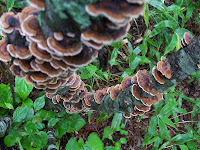
Crane is a glass case. (The crane is on the right.)

Fen tussock








The red-crowned Japanese Crane was a sacred symbol to the Ainu (who called it Sarurun Kamui, The God of The Marshes) and later the Japanese in the south, who called it Tancho and wove it into folk tales. These birds were plentiful when the marshes were healthy. Successive administrations - like governments all over the world - saw "bogs" and "mires" as wastelands, not wetlands and believed that progress meant draining swamps to establish forest plantations and agriculture. There was also indiscriminate hunting for their magnificent feathers.
By the Meiji era, the crane was considered to be totally extinct. Then in 1924 a colony of about a dozen birds was found in this region. Local villagers began hand-feeding the remaining birds to get them through the harsh winter. In one of ecology's success stories, the Japanese Crane numbers are now well over 1000, with a further estimated 1500 in Siberia and Northern China. (While the Japanese Crane flies well, it doesn't migrate.)
Their wingspan can be up to 2.4m. In good conditions they often live more than fifty years. Pairs mate for life. Their graceful dance has to be seen to be believed. We'll be grateful if we can see just one in the wild...
We spent two days exploring the Kushiro Marshlands by train, bus and a lot of hiking (much of it in the rain!) We saw a sika deer and dozens of beautiful wetland flowers and insects.
But no cranes.


No comments:
Post a Comment